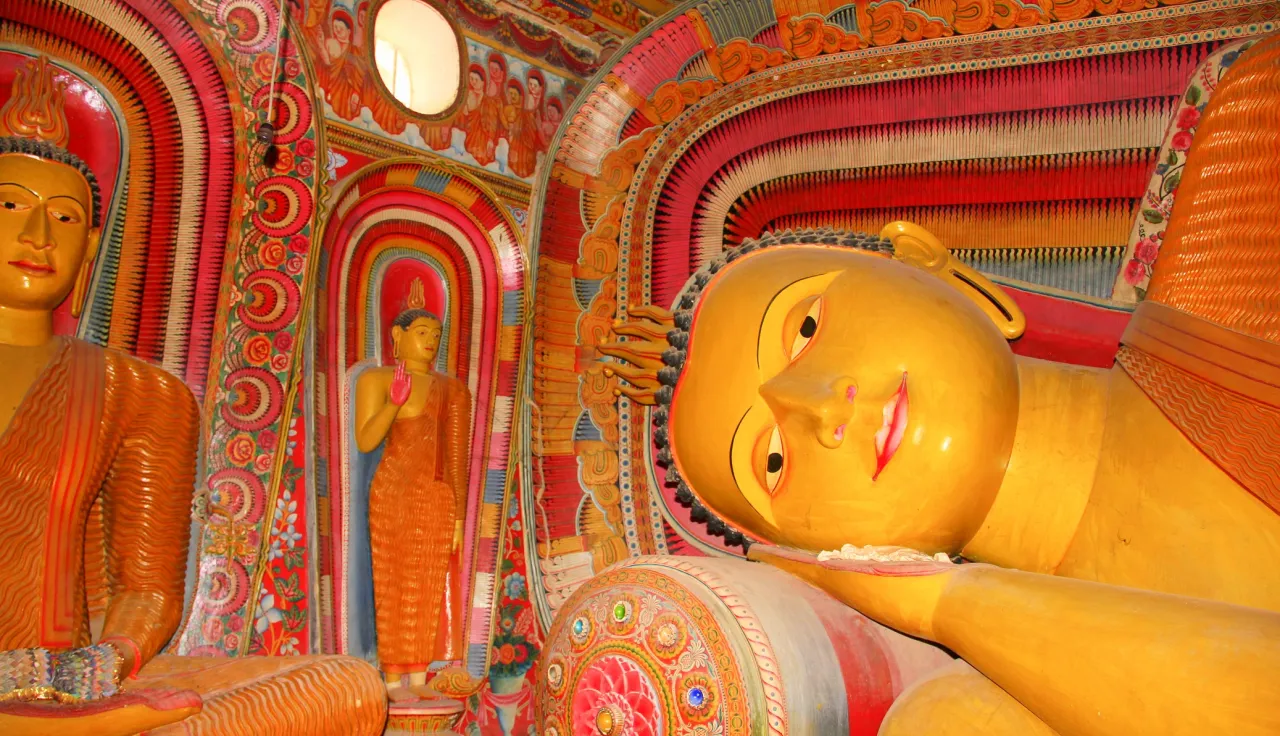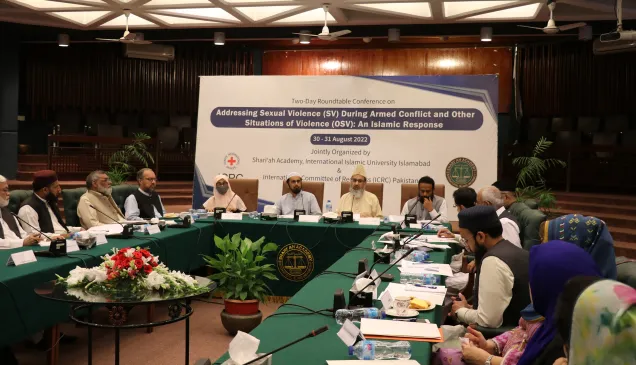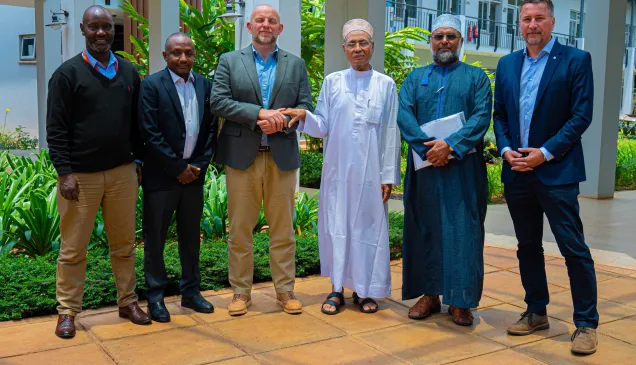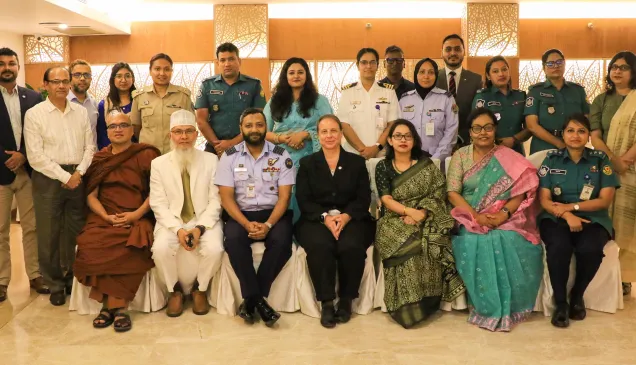Reducing Suffering During Armed Conflict: The Interface Between Buddhism and IHL

International Conference - Dambulla, Sri Lanka, 4-6 September 2019
From 4 to 6 September 2019, over 120 participants from around the world gathered in the historic town of Dambulla, Sri Lanka, for an international conference on "Reducing Suffering During Armed Conflict: The Interface Between Buddhism and International Humanitarian Law (IHL)". The conference was organised by the ICRC in collaboration with a number of universities and organisations, including leading international Buddhist scholars, monks, legal experts and military personnel from the Theravada, Mahayana and Vajrayana traditions.
Though there are over half a billion Buddhists around the world, there had thus far been no systematic and focused study of the interface between Buddhism and International Humanitarian Law (IHL). The core of IHL – also known as “the law of war” or “the law of armed conflict”– is formed by the Geneva Conventions and their Additional Protocols. Its purpose is to minimize suffering during armed conflict by protecting those who do not – or no longer – participate directly in hostilities, and by regulating the means and methods of warfare.
At Buddhism’s core is the recognition of suffering and the promotion of means to alleviate it, by changing challenging our understanding and making changes to our conduct. It has applied these means both to the quest for salvation and to the troubles that afflict society, and has grappled with the reality of war throughout its long history. This suggests a possible convergence of some of the aims of Buddhism and IHL. But what guidance does Buddhism provide to those caught up in the midst of hostilities, and how do Buddhism and IHL compare in this respect? It was timely and relevant to explore these two distinct bodies of ethics and legal traditions from inter-disciplinary perspectives.
The conference explored correspondences between Buddhism and IHL and encouraged a constructive dialogue and exchange between the two domains. It furthermore acted as a springboard to understanding how Buddhism can itself contribute to regulating armed conflict, and what it offers in terms of guidance on the conduct of, and behaviour during, war for Buddhist monks and lay persons – the latter including government and military personnel, non-State armed groups and civilians. The conference was concerned with the conduct of armed conflict, and not with the reasons and justifications for it, which fall outside the remit of IHL.
In addition, the conference also explored how Buddhist combatants and communities understand IHL, and where it might align with Buddhist doctrines and practices: similarly, how their experience of armed conflict might be drawn upon to better promote IHL and Buddhist principles, thereby improving conduct of hostilities on the ground.
While the conference featured the presentation of over 40 academic research papers, Buddhist monks, chaplains, and active and retired military personnel contributed to debate on how Buddhist teachings and technologies might actually be applied in high-stress armed conflict situations. In the course of proceedings, participants also discussed how Buddhism could complement and enrich IHL by supporting victims of armed conflict, or instituting training regimes for armed forces to heighten self-awareness and improve discipline by incorporating a diverse range of Buddhist meditation techniques.
Papers presented at the conference addressed at least one of the following lead questions:
- What correspondences are there between Buddhist ethics and IHL?
- Where does IHL fit into Buddhist doctrines and practices? Which Buddhist teachings and traditions are most relevant to IHL and situations of armed conflict?
- What measures are helpful in regulating warfare and reducing suffering during armed conflict according to Buddhist teachings and traditions?
- How do Buddhist communities conceptualize and understand IHL, and where can IHL be seen to align with Buddhist doctrines and practices?
- What level of agreement and commitment for IHL – in general, and its various specific aspects – can be expected from Buddhist communities? What is a Buddhist theoretical position on IHL and how can Buddhists engage with this body of law?
- What practical guidance and resources can Buddhist teaching and practice provide to Buddhist combatants and communities involved in armed conflict, and also what direct experiences of armed conflict can be drawn upon to help improve the conduct of hostilities?
- To examine and document Buddhist religious teaching, practices and approaches to specific IHL-related problems such as the handling and treatment of casualties and dead bodies during armed conflict, and the treatment of prisoners of war/detainees.
- To examine how the application of Buddhist principles has had a positive effect on the conduct of armed conflict in Buddhist history.
The conference is part of a larger project exploring Buddhism's wealth of insights into the human condition and how they can contribute to minimising suffering during armed conflict. "This event is not the culmination of the work done so far, but just the beginning of a project on Buddhism and armed conflict which we hope will extend over many years, including the publication of a book to lay the foundations for further study" stated Andrew Bartles-Smith, the ICRC's Regional Manager for Global Affairs. "We are here to initiate a process of exploration and learning between diverse scholars and to plant a seed for future research and development. After all, minimising suffering lies at the very foundations of both Buddhism and IHL."
As part of the project, a number of respected Buddhist scholars have been working with the ICRC to produce an exploratory position paper on Buddhism and IHL (latest draft available here) which attempts to explore some of the territory to be covered in terms of topic, sources and approaches, in such a way as to familiarize readers with some of the existing coverage and related debates.
Further enquiries concerning the conference, the exploratory position paper and other related matters should be addressed to:
Mr. Andrew Bartles-Smith at anbartlessmith@icrc.org
The ICRC and its network of Buddhist and IHL experts will then endeavour to assist.
INTERNATIONAL HUMANITARIAN LAW (IHL)
International Humanitarian Law (IHL) is a set of rules that seek to limit the effects of armed conflict. It protects the lives and dignity of persons who do not, or no longer, participate in hostilities, and imposes limits on the means and methods of warfare. The core of IHL is comprised of the Geneva Conventions of 1949, which have achieved universal ratification, and their Additional Protocols.
Warfare has always been subject to certain principles and customs. It may therefore be said that IHL has its roots in the rules of ancient civilizations and religions. Universal codification of IHL began in the nineteenth century, notably through the adoption of the first Geneva Convention of 1864. Since then, States have agreed to and codified a series of practical rules to keep pace with evolving means and methods of warfare and the related humanitarian consequences.
IHL strikes a careful balance between humanitarian concerns and the military requirements of States and non-State parties to armed conflict. It addresses a broad range of issues, including: protection for wounded and sick soldiers; treatment of prisoners of war and other persons detained in connection with an armed conflict; protection for the civilian population and civilian objects; and restrictions on the use of certain weapons (such as biological and chemical weapons and anti-personnel mines) and methods of warfare. As a general rule, IHL prohibits means and methods of warfare that cause superfluous injury or unnecessary suffering, including those that disrupt livelihoods and cause severe damage to the natural environment.
More specifically, it is forbidden to kill or wound an enemy who surrenders or is unable to defend himself or herself. The wounded and the sick must be collected and cared for by the party in whose power they find themselves. Medical personnel, units and transports must all be protected. Access to humanitarian assistance for the civilian population affected by the conflict must be facilitated, subject to the consent of the parties concerned. In addition, detailed rules govern the conditions of detention for prisoners of war and the treatment of civilians under the authority of an enemy power. Outrages to personal dignity such as rape and torture are prohibited.
Protected civilian objects include cultural property, places of worship and objects indispensable to the survival of the civilian population (such as crops, dams and dykes), as well as works and installations containing dangerous forces (such as nuclear power plants).
IHL regulates the general conduct of hostilities on the basis of three core principles: distinction, proportionality, and precaution. The principle of distinction requires that the parties to an armed conflict distinguish at all times between civilians and civilian objects on the one hand, and combatants and military objectives on the other, and that attacks may only be directed against combatants and military objectives. The purpose of this is to protect individual civilians, civilian property, and the civilian population as a whole. Under this principle, indiscriminate attacks are prohibited. The principle of proportionality, a corollary to the principle of distinction, dictates that incidental loss of civilian life and property or injury to civilians must not be excessive in relation to the concrete and direct military advantage anticipated. In order to implement the restrictions and prohibitions on targeting, the principle of precaution requires all parties to an armed conflict to take specific precautions such as, when conducting an attack, to verify that targets are military objectives or to give the civilian population an effective warning before the attack. It can also entail restrictions on the timing and location of an attack.
IHL is part of international law – the body of rules governing relations between States made up primarily of treaties or conventions, customary rules and general principles of law. Distinction must be made between IHL, which regulates the conduct of parties engaged in an armed conflict (jus in bello), and another part of international law set out in the Charter of the United Nations, that regulates whether a State may rightfully resort to armed force against another State (jus ad bellum). Thus, IHL applies only during armed conflict and does not concern itself with justifications for war, conflict prevention, peacebuilding, conflict resolution or reconciliation.
For more information on IHL, the ICRC Resource Centre on our website, in particular the war and law page, is an invaluable resource, containing everything from introductory material to the full texts and commentaries of the Geneva Conventions, Additional Protocols and other instruments. Meanwhile, here are a brief factsheet on IHL, a five-minute film, and a comprehensive introductory book on IHL. Many more factsheets on IHL and related subjects can be accessed here. Please do not hesitate to contact us for further information.
The following is extracted from the longer Position Paper on Buddhism and IHL which develops these themes in greater detail. We recommend that you read these two sections first.
GENERAL BUDDHIST ATTITUDE TO ARMED CONFLICT
In “Buddhism and Humanitarian Law” (Handbook of International Humanitarian Law in South Asia 3, 2007), the Sri Lankan born jurist Christopher Gregory Weeramantry (1926–2017) comments regarding Buddhism:
In a system where the institution of war is not recognized [as truly valid] there will naturally be little or no discussion of actual conduct in warfare. The applicable principles will need to be worked out with reference to its general principles regarding the dignity and sanctity of human life, its general principles relating to the treatment of and attitudes towards other human beings, its respect for nature and life-support systems and its concepts on proper behaviour in general.
Weeramantry’s statement is useful in identifying Buddhism’s broad approach to war and therefore the importance of looking to its broader and implicit principles. Buddhist canonical texts do contain many references to war, and many military images, similes and metaphors, as well as references to ways of mitigating the effects of war and of retaining integrity in situations of conflict. Buddhism recognizes that wherever ethically imperfect beings live, strife, disharmony, disputes and conflicts are inevitable as long as their social behavior is influenced by unwholesome psychological traits like greed, anger, and narrowness of vision.
According to the Buddha, such conflicts arise within every conceivable social grouping ranging from the smallest, the family, to those of the highest complexity like politically organized states (M.I.86). The empirical realism of early Buddhist texts shows that the historical Buddha and early Buddhist communities were very much aware of the reality of war, violence and armed conflict, namely the institution of war, and how to minimize trauma within a world that was fundamentally traumatizing. This suggests that there is no in-principle difficulty for Buddhism to accept IHL.
The Jātaka stories are about past lives of the Bodhisatta or Buddha-to-be, in which he was gradually, over many, many lives, developing the qualities that would enable him to attain Buddhahood. This literature explores many themes of practical ethics in the world of saṃsāra, and often refers to inter-state wars. It is clear that a considerable core of ethical principles relating to war that have convergence with those underlying IHL are discoverable within this body of Buddhist stories. There is no doubt that they represent key aspects of the Buddhist ethical vision relating to the conduct of war, complementing the principles found in the suttas and other texts.
Buddhism has also paid much attention to the causes of conflict at both the personal and collective level, especially unskillful/unwholesome (akusala) mental states rooted in greed, hatred and delusion. Buddhism’s analysis of the psychological realities of the human condition is arguably its greatest potential contribution to enhancing interpretations of IHL. In the light of human psychology, Buddhists accept that conflict is almost inevitable, and we therefore find elements in Buddhist teachings that correspond directly to IHL, as well as elements that might enhance it. Within the practical realities brought about by limited resources and the human condition, how should Buddhists work to ensure IHL is adhered to once war has broken out?




